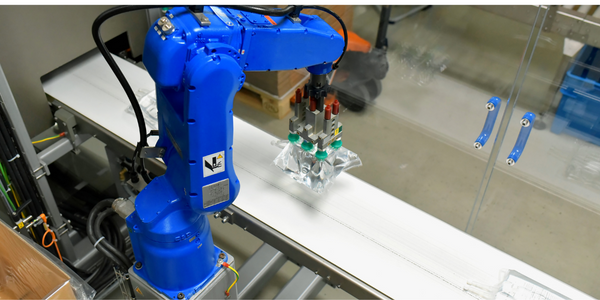Pioneering Lead Generation with Conversational Messaging: A Case Study of Open Universities Australia


Applicable Functions
- Product Research & Development
- Sales & Marketing
Use Cases
- Chatbots
- Time Sensitive Networking
The Customer
Open Universities Australia (OUA)
About The Customer
Open Universities Australia is an online higher education organization that offers a wide range of courses from leading Australian universities. In 2019, they were catering to 25,000 students and were in the process of rebuilding their digital platform. They were looking for ways to improve their service and streamline their processes, particularly in terms of lead generation and customer engagement. They were also exploring ways to better understand their customers and serve their needs more effectively.
The Challenge
In 2019, Open Universities Australia (OUA) decided to transition from live chat to conversational messaging, coinciding with the rebuilding of its digital platform. The goal was to enhance service for the 25,000 students they were catering to at the time. However, the contact centre required all students to create a new password, a task that posed significant challenges in a non-automated world. Additionally, OUA was using Facebook ads that linked to a form, which then funneled details to an outbound team for follow-up. This method was not particularly effective in terms of sales or user experience.
The Solution
OUA adopted an iterative approach to automated messaging solutions, starting with prototyping, testing, learning, and iterating. AI chatbots were initially used to assist students in creating a password on the new website, thereby deflecting inbound traffic and saving student advisors significant time. This successful deployment of chatbots spurred an appetite for more AI-powered customer engagement in the business. OUA became the first LivePerson client in Australia to launch Facebook Messenger as a lead generation tool. Instead of linking ads to a form, they linked to a conversational messaging chatbot that qualified the lead and delivered prospects seamlessly to a live student advisor for closing the sale. This approach was so successful that lead forms were quickly dropped in favour of Conversational AI.
Operational Impact
Quantitative Benefit

Case Study missing?
Start adding your own!
Register with your work email and create a new case study profile for your business.
Related Case Studies.

Case Study
Centralizing Data for Improved Efficiency: A Case Study on Malvern Panalytical
Malvern Panalytical, a UK-based hi-tech electronics company, was grappling with the challenge of decentralized data storage. The company had a vast amount of unstructured data scattered across various platforms, from hard drives to emails and floppy disks. This made the data searching process extremely cumbersome and inefficient. The company's rapid growth, from 200 to over 1,000 employees in a decade, and expansion across three continents further exacerbated the need for a more structured and centralized data system. As a company involved in electronics manufacturing and software development, it was crucial for Malvern Panalytical to find a platform that could structure all their data, track all modifications of documents in real time, and provide clear visibility of the internal information flow across all its facilities.

Case Study
Managed Hosting Platform
Formula 1® is a sport where every millisecond matters. With changing preferences and the growth of the digital medium, many fans choose to experience the sport through the F1.com website. The website needs to deliver a superior experience to tens of millions of fans across the world consistently. Hence, it is imperative to have a robust platform that can deliver the required performance and scale with growing trac and dynamic fan expectations. Some of the key challenges are: • Every race weekend, Formula1.com attracts up to 7 million fans. Managing this huge surge in website traffic, requires a scalable hosting platform that can simultaneously allow millions of fans to experience the excitement of the sport seamlessly. • Fans across the globe expect an engaging and immersive experience through enriched and enhanced race content across multiple devices. To meet this requirement Formula1.com needs to have a robust platform that is able to deliver real-time updates and information across screens, be it tablets, TVs or smartphones. • A global brand like Formula 1® needs to ensure it delivers a consistent user experience across all platforms across the globe. This consistent delivery of enriched content cannot be compromised through downtime or any other issue at any point. • In an age where threats to global websites are prevalent, Formula 1® needed a platform that was ready to meet any challenge to its website. They needed a solution that delivers consistency, scalability and yet at the same time is continuously monitored, secure and reliable.

Case Study
HSBC's Transition to Conversational Banking through Intelligent Automation
HSBC, one of the world's largest banking and financial services organizations, was facing a challenge with its customer service operations. With over 19,000 customer service agents, the bank was dealing with a high volume of repetitive tasks that put pressure on its agents. The traditional career path in the contact center world was also leading to inevitable attrition, as it was defined as agent → team manager → department manager → operations manager → head of contact centre. This lack of opportunity as the field narrows held back the chance of reaching the highest possible customer satisfaction with every interaction. Furthermore, HSBC was planning to shift towards Conversational Banking, which was expected to grow interactions considerably and require conversational experts to manage the chatbots.

Case Study
Flow Robotics: Scaling Up Production and Accelerating Product Development with IoT
Flow Robotics, a Danish manufacturer, developed flowbot™ ONE pipetting robots to alleviate the strain on bioanalysts in life-science laboratories and hospitals across Europe. These robots were designed to automate part of the testing process, speeding up the time it takes to produce results and reducing pressure on staff. However, the company faced challenges in scaling up production and accelerating product development. High workloads and physically challenging conditions have long been an issue for laboratory professionals. Flow Robotics estimates that around half of medical lab technicians carry out the same arm movements for at least a quarter of their working day. The American Society for Clinical Pathology reported that 85% of laboratory professionals feel burnt out; 36% struggle with inadequate staffing; and 32% face a heavy workload and pressure to complete all testing on time.

Case Study
EDF's Transformation: Enhancing Employee Experience through IT Modernization
EDF, a major UK utilities company, was grappling with a highly customized service management system that was largely manual, with limited potential for automation. This made it difficult to predict or prevent system failures and provide a resilient service. The company's IT system for incident handling was purely manual, leaving no room for modernization. EDF wanted to serve its business and residential customers better by improving the response time to rising energy demands. To achieve this, the company needed to provide its employees with the right tools for improved productivity, better collaboration, and an enhanced IT experience at a reduced cost to serve.



